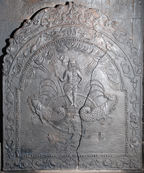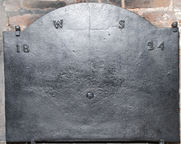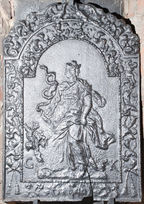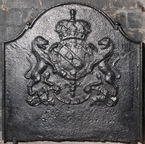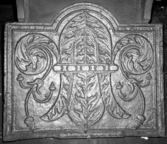-
942
Description: Rectangular with a central rectangular extension; twisted rope edging; fleur-de-lys stamp with twisted band repeated three times at top; ?rose stamp repeated five times in line below fleurs, some over pressed, central rose above others; cabled anchor stamp repeated twice, either side of central rose; initials below central rose; ?cow and dog stamps each repeated twice alternately in line below initials; eight rivets from later repair.
Notes: None of the stamps is known from any other fireback; cabled anchor may suggest a connection with a seaport.
Inscription: HI
- Decoration tags:
- rectangular with square arch (shape)
- rope (edging)
- simple stamps
- carved stamps
- individual letters
- heraldic
- text
- animals
- plants
- objects
Manufactured: in the early-17th century in England.
Current location: Wilberforce House, High Street, Kingston upon Hull, Yorkshire, England.
(part of the Hull Museums museum group)
- Attached to series:
- Miscellaneous stamp firebacks
-
341
Description: Arched rectangular shaped central panel with ’nutshell,’ paternost edging on a broad fillet; figure of Neptune/Poseidon holding a trident in his right hand, standing on a pedestal in the centre of a circular fountain, with two hippocampi, water issuing from their mouths; in front, a mermaid swims in waves, her arms raised; behind, blasts of wind issue from clouds; arched rectangular border with fillet edging; symmetrical design of seashells suspended from chains of pearls; bottom centre, the monogram between swirled plant tendrils; on top, symmetrical floral swirls.
Notes: Although very similar in size and design to a fireback in the 1724 series, this is not based on a design by Daniel Marot; instead it may have been inspired by the design for a fountain by Jean Lepautre (1618-82) published in a set of 12 etchings by Jean Le Blond in 1650. Almost certainly the 'iron chimney back' purchased by Henry Campion, of Danny, from John Legas for two guineas in 1731; another example, presumably from the same source, is at The Vine, near Basingstoke, Hampshire.
Copies of this fireback are known.
Inscription: SHR
- Decoration tags:
- 'Dutch' (shape)
- fillet (edging)
- whole carved pattern
- pictorial
- architectural
- text
- animals
- humans
- objects
Manufactured: in the early-18th century possibly at Gloucester Furnace, Lamberhurst in the Weald area of England.
Current location: Danny House, Hurstpierpoint, West Sussex, England.
Citation: Brent, C. & J., 2013, Danny House (Chichester, Phillimore), pp. 58-9.
- Attached to series:
- SHR series
- British 'Dutch' style firebacks
-
981
Description: Arched rectangular shape; fillet edging; broad, fillet-edged central panel with pictorial landscape and battle scene; on top, above a cone of laurel leaves, a crown supported by two putti, each holding a plant stem; on each side, a flower and fruit festoon suspended on a ribbon from a ring; at the bottom , inscription on a scroll.
Notes: The pictorial scene is alleged to be the Siege of Namur of 1695 in which British and Dutch forces, under the leadership of William III, defeated the French forces of Louis XIV, however details of the scene more closely resemble those seen in images of the Siege of Vienna in 1683, an iconic victory of the Christian powers over the Ottoman Turks.
Copies of this fireback are known.
Inscription: NON[...]ROSEDARMIS / N ANNO 1695 L
- Decoration tags:
- 'Dutch' (shape)
- fillet (edging)
- whole carved pattern
- individual letters
- pictorial
- text
- animals
- humans
- plants
- objects
Manufactured: in 1695 possibly in the Siegerland area of Germany.
Current location: Swakeley's House, Ickenham, Middlesex, England.
Citation: Godfrey, W. H., 1933, Survey of London Monograph 13, Swakeleys, Ickenham (London, HMSO).
- Attached to series:
- 'Dutch' 1695 Crown series
-
347
Description: Rectangular; twisted rope edging (top and sides); central Tudor shield, garter, crown and supporters (greyhound and lion), formed from separate stamps; date on a single stamp in top left corner.
Notes: The worn appearance of the central arms, compared with the clarity of the date, suggests that this is an early example of a fireback being used as a pattern, with the addition of a subsequent date. The same stamps forming the arms can also be seen on other firebacks. The extension of the lower part of the ‘3’ on the date stamp suggests that the numbers may have been fixed to the backing block, rather than the date being carved as a whole. Another variant of this fireback has the rope edging extending only three-quarters of the way down the sides.
Inscription: 1583
Arms: Tudor royal
- Decoration tags:
- rectangular (shape)
- rope (edging)
- carved stamps
- date stamp
- armorial
- royal
- text
Manufactured: in 1583 in the Weald area of England.
Current location: Ightham Mote, Ightham, Kent, England.
Museum number: 825358 (part of the National Trust museum group)
- Attached to series:
- Pounsley series
- Tudor royal armorial firebacks
- Tudor redated series
-
343
Description: Arched rectangular shape; no edging; initials evenly spaced around arch; date split between top corners.
Inscription: W S / 18 24
- Decoration tags:
- rectangular with round arch (shape)
- none (edging)
- individual letters
- individual numbers
- text
Manufactured: in 1824 in England.
Current location: Ightham Mote, Ightham, Kent, England.
Museum number: 825375 (part of the National Trust museum group)
- Attached to series:
- Date & initials firebacks
-
344
Description: Arched rectangular central panel, with bead-and-pellet edging; pictorial, standing female figure in classical dress, facing to the left, holding a snake in her right hand, a bunch of flowers at lower left; the initials located in bottom corners; arched rectangular border, fillet edging, containing swirled foliage, with a putto in the top corners; on top, two perched bird facing each other, with swirled foliage descending behind them.
Notes: The figure is of Sapientia, or Wisdom, based closely on an engraving, one of a set entitled 'The Virtues' by Hendrik Goltzius c.1593; a small number of firebacks bear the initials, GK; it is not known to whom they refer, but dated ones are of 1700.
Copies of this fireback are known.
Inscription: G K
- Decoration tags:
- 'Dutch' (shape)
- fillet (edging)
- whole carved pattern
- pictorial
- allegorical
- text
- humans
Manufactured: in the early-18th century in the Siegerland area of Germany.
Current location: Ightham Mote, Ightham, Kent, England.
Museum number: 825381 (part of the National Trust museum group)
- Attached to series:
- 'Dutch' GK series
-
345
Description: Rectangular; twisted rope edging (top and sides); from top, crowned Tudor royal shield (stamp overpressed) above crowned shield bearing initials, KH in Lombardic lettering, above a fleur de lys (stamp overpressed); to left, diagonal lion passant guardant sinister; to right, diagonal lion passant; at base, single 'imp' figure, arms to side, moving left but facing right, between two pairs of 'imp' figures (separately stamped), one moving left, right arm raised, the other moving right, right arm raised.
Notes: One of the 'Royal' series.
Arms: Tudor royal arms of England
- Decoration tags:
- rectangular (shape)
- rope (edging)
- carved stamps
- heraldic
- armorial
- animals
- humans
Manufactured: in the mid-16th century in the Weald area of England.
Current location: Ightham Mote, Ightham, Kent, England.
Museum number: 825393 (part of the National Trust museum group)
- Attached to series:
- Royal series
-
346
Description: Rectangular with arched rectangular shaped top joined by cavetto curves; astragal edging; shield, supporters, ducal coronet, motto and garter of the Duke of Dorset: Quarterly, Or and gules, a bend vair.
Notes: Almost certainly the arms of Lionel Sackville KG (1688-1765), created first duke of Dorset in 1720.
Copies of this fireback are known.
Inscription: [around shield] HONY SOIT QUI MAL Y PENSE / [on motto scroll] AUT NUNQUAM TENTES, AUT PERFICE
Arms: Lionel Sackville, 1st Duke of Dorset
- Decoration tags:
- rectangular with canted top corners and round arch (shape)
- astragal (edging)
- carved pattern panels
- text
Manufactured: in the early-18th century in the Weald area of England.
Current location: Ightham Mote, Ightham, Kent, England.
Museum number: 825513 (part of the National Trust museum group)
- Attached to series:
- Dorset arms series
- Personal armorial firebacks
- Sackville firebacks
-
843
Description: Canted rectangular shape; double fillet edging (top and sides) with alternating roses and diamonds between the fillets; pictorial scene of Adam and Eve, both naked, taking fruit from the Tree of Knowledge, between them, around which is entwined the serpent.
Notes: Boldly sculpted, stylised figures; the serpent is shown with a human face.
Copies of this fireback are known.
- Decoration tags:
- rectangular with canted top corners (shape)
- double fillet (edging)
- whole carved pattern
- planklines
- pictorial
- biblical
- animals
- humans
- plants
Manufactured: in the late-16th to early-17th century possibly in the Lorraine area of France.
Current location: Old Manor House, Ilkley, West Yorkshire, England.
(part of the Bradford Museums and Art Galleries museum group)
- Attached to series:
- Old Testament & Apocrypha firebacks
- Adam & Eve firebacks
-
352
Description: Arched rectangular shape; cyma curve and astragal edging; fleur de lys formed from acanthus leaves within a circlet, between swirled, budded fronds, all in bas-relief.
Notes: An uncommon English fireback with a purely floral design.
Copies of this fireback are known.
- Decoration tags:
- rectangular with round arch (shape)
- cyma curve and astragal (edging)
- whole carved pattern
- heraldic
- plants
Manufactured: in the mid-17th century in England.
Current location: Christchurch Mansion, Ipswich, Suffolk, England.
(part of the Colchester & Ipswich Museums Service museum group)
- Attached to series:
- Miscellaneous pattern firebacks

